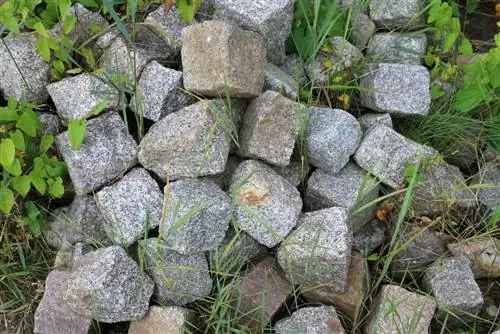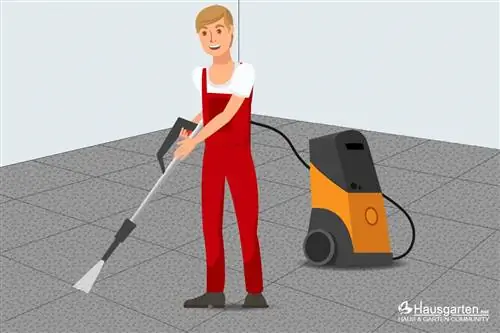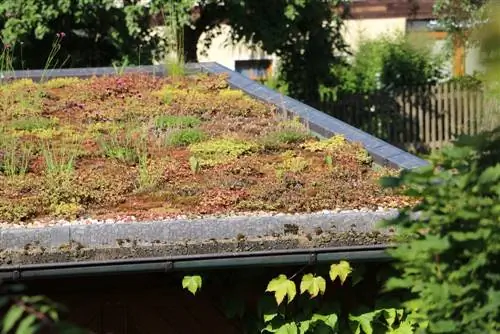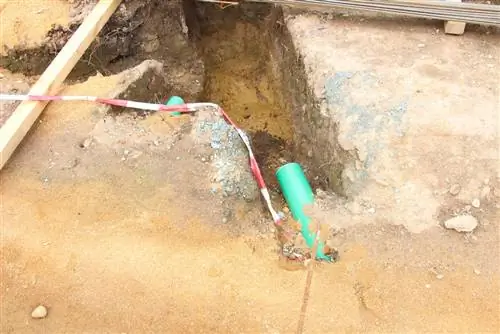- Author admin [email protected].
- Public 2023-12-23 21:05.
- Last modified 2025-01-24 12:45.
You can save all kinds of costs, but only if the work to be done is carried out properly and cleanly and you don't have to do it again after a few years because the paving stones shift or slip away.
Tips for paving the driveway
- After excavating the earth, the surface of the subsoil must be properly compacted. It must allow water to pass through, but at the same time it must be stable and not deform. It is important for the paved area that all required longitudinal and transverse slopes are taken into account in all views. A gradient of 1.5 to 2 percent should generally be planned for. For water-sensitive soils it should even be 2 to 4 percent. Paving ceilings always require a stable edge edging. This is built before paving. Individual rows of stones are laid out as a test so that the edge border matches the pattern of the paving stones and closes correctly without having to cut stones. When laying patterns, cutting cannot usually be completely avoided.
- Curb and edging stones must be placed on a concrete foundation at the correct height and alignment.
- Always install drainage channels with an inclination, also in a concrete foundation and with expansion joints.
- The bedding for the paving must be the same height everywhere, so the angle of inclination must be taken into account when excavating.
- Lay paving stones with sufficient joint spacing. Avoid press laying!
- Even course of joint axes. Ensure straight-line joints by tensioning cords lengthwise and crosswise.
- If stones need to be cut, it is best to use the wet cutting process.
- When excavating, pay attention to underground pipes!
- It is best to start laying on a straight, rectangular edge.
The substructure
The substrate is very important to give the paving stones stability. It has to be resilient, especially on paved surfaces where cars drive and stand. The substructure must therefore be carried out professionally. It is important that it withstands the weight, supports the steering movements, prevents washouts and that frost cannot cause damage. The substructure consists of a layer of gravel, followed by a layer of gravel and finally fine chippings. It is important to calculate the structure beforehand so that you know how far the ground needs to be excavated. For paved surfaces that can be driven on, a 25 cm thick layer of gravel, a 25 cm thick layer of gravel and a 5 cm thick layer of gravel and sand are assumed. In addition, there is the actual stone height, usually 8 cm.
- Measure and mark out the planned area. Make sure that curbs are laid on the sides.
- Calculate the amount of material and order it.
- Plan for gradients
- Dig up the earth, preferably with a small excavator that can be rented. For large areas, remember that the excavation can be used somewhere or has to be removed.
- Create a gravel bed
- Fill up layer by layer of gravel and consolidate again and again with the vibrator
- Fill gravel layer
- Here too, working shift by shift and shaking things off every now and then
- Last comes the layer of grit with laying sand
- This layer is smoothed out at the end, preferably with the squeegee
- Pay attention to the gradient for all layers, it should be around 2 percent
- The gravel bed is also shaken
Pave driveway
Of course, the selection of paving stones is crucial to ensuring that the work is successful. Laypersons should not attempt complicated patterns straight away, but rather remain modest for now. In principle, any paving stone can be used for driveways. Interlocking paving stones are often used. They are usually gray, but there are now other colors too. Composite paving is particularly robust, can withstand high loads, is weather-resistant and easy to care for. They come in numerous shapes, for example honeycomb, rectangular, circular or as T or double T bricks. Numerous laying patterns can be realized in this way.

If the plain concrete paving stones seem too unattractive, you can use rolled, rumbled or polished paving stones. These have the same stability. Lawn pavers are the cheapest. You can get them from just 6 euros per m². Otherwise the prices are between 10 and 25 euros, with no upper limit. Concrete paving for over 100 euros per m² is also not uncommon. The light gray composite stones are cheap and often on offer. They include bone stones or the rectangular shapes. Of course, extras such as refined surfaces or the addition of color pigments increase the price. It becomes more expensive if complicated laying patterns have to be designed. Mosaic paving is significantly more expensive than normal paving. Stones that allow water to seep away also cost more than those that are impermeable to water, although wastewater costs are incurred for such sealed areas. At https://www.heuchert-betonwaren.de/preisliste.html you can find a PDF, a provider's price list with pictures and laying patterns, where you can get basic information about what is available and approximately how much it costs.
- To pave, a guide line is stretched on the sides, always on the opposite sides.
- The gradient must be taken into account. The cord is adjusted to the height that should be achieved with the plaster, taking into account that at the end it will be shaken again and the surface will sink by about 1 cm.
- Simply place the stones in the prepared bed according to the pattern and tap them in a little with a rubber mallet. Always stick to the pattern.
- It is very important to keep the distance between the individual stones very evenly. The distance should be neither too small nor too large. The stones must not have too much room for maneuver so that they can subsequently shift or even tip over.
- When laying straight patterns, always use lots of cords to ensure the pattern stays straight.
- Lay 10 to 15 rows together.
- Edge areas that are initially without stones due to the patterning remain open for now. In the end, these positions will all be closed one after the other. To do this, paving stones have to be cut and it is better to do this in one step.
- Normally thick stone paving is best cut with a stone cracker. The device is quiet and hardly any dust is generated. If the pavement is thick, you usually have to use a wet cutter, which is very loud. It's also a dirty thing.
- The cut stones are inserted last.
- When all the stones have been laid, the entire area must be shaken again. It is important that the vibrating plate must be equipped with a plastic shield so that no stones break or corners break off.
- Sand is then spread over the entire area. This is distributed into the joints with a broom. If you like, you can use a water hose to help with compaction, but the next rain will do the trick too. Once the sand has settled through the water, it usually has to be applied again or several times and swept into the joints until they are completely sealed.
Prices for laying and materials
Prices can vary quite a bit, both in terms of paving stones and other materials, as well as labor costs. It is always advisable to get several offers. When it comes to materials, the delivery price is often a larger item. Although there may be offers where the materials are cheaper, transport and delivery increase the costs higher than with other providers where the materials are initially more expensive. Comparing is almost always worthwhile.
- The paving stones, as described above, cost between 10 and 25 euros per m²
- The cubic meter of gravel or gravel costs around 15 euros
- For crushed sand, the bin also costs around 15 euros
- Curbs for edging cost 2 to 3 euros per running meter
- Concrete should not be forgotten to set in concrete the curbs
- A mini excavator costs around 100 euros a day, but it makes the job a lot easier.
- A company charges 40 to 60 euros per hour for excavation.
- Delivering and installing gravel costs around 10 €/m²
- For laying chippings it is around 5 €/m²
- Laying the plaster costs between 15 and 100 euros, depending on the pattern
- The side borders cost around €15 per meter
It folds together. So you can say that the square meter of laying paving costs between 50 and 100 euros if you have it done and start with the excavation, including the removal of the excavation, through the creation of the paving bed with edging and paving, provided you don't want to have elaborate patterns. So paving the driveway yourself is worth it. Labor costs of professionals are high. One can only hope that they do a good job.
Conclusion
Of course you can pave your driveway yourself. This will definitely take longer than letting a professional do the work, but it will also be significantly cheaper. If you have to watch your money, you should be careful when planning. Get several offers, haggle a bit, do a lot yourself and only commission what you don't really trust yourself to do. The substructure is important, it holds the entire area. The sides that support everything must also be well crafted. The actual paving is the easiest part of the whole process, at least if you choose a fairly simple pattern. Friends who assist and help are worth their weight in gold in this case. Experiences are important.






